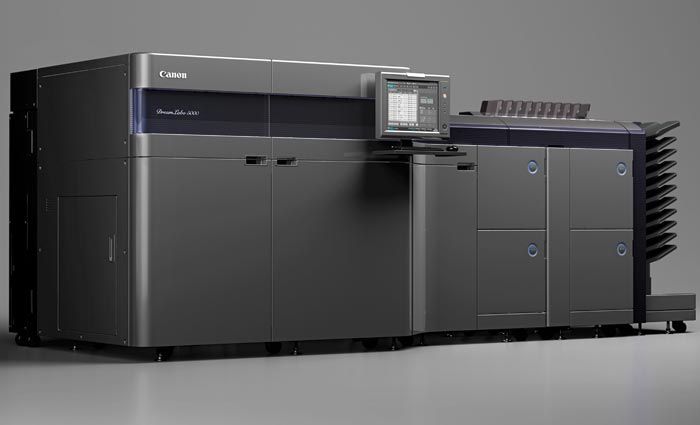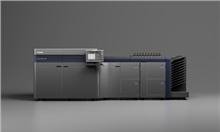
When was the machine launched and what market is aimed at?
Canon’s DreamLabo 5000 was launched at an event at Canon’s HQ in Sydney in March. It is aimed at what Canon describes as “wholesale photo finishers” looking to switch from silver halide technology to digital as well as photobook printers who are currently using other digital machines, notably HP Indigos.
“The market for photobooks continues to grow rapidly. With consumers demanding high-quality printed images, Canon has extended its renowned inkjet technology to create a commercial printer that raises the standard of image quality,” says Gareth Thomas, Canon’s development manager, Digital Imaging.
How does it work?
The DreamLabo uses Canon’s thermal Full-photolithography Inkjet Nozzle Engineering (FINE) technology, similar to that found on its Pixma range of consumer printers and the ImagePrograf wide-format machines. However, it has woven the heads into the 305mm-wide high-density array that enables a resolution of 2,400×1,200dpi. The duplexing web-fed press comes with an onboard RIP and trimmer, enabling it to process 600dpi 8-bit RGB files, which it converts to 2,400dpi, and output trimmed prints.
The machine offers a double ink tank system for on-the-fly replenishment and a standard double magazine paper feeder, which can be upgraded to a quadruple system. Like the photobook market leader HP Indigo, it uses a seven-colour inkset, CMYK plus photo magenta, photo cyan and grey and, according to Katsuichi Shimizu, Canon’s chief executive for inkjet products, it boasts an optical density of 2.2, which “is beyond that of HP Indigo or even Heidelberg”.
Have there been any sales?
The first installation anywhere in the world was at Melbourne’s PictureWorks.
What’s its USP?
At first glance, it is print quality, pure and simple. While Canon claims that not only is its image quality “overwhelmingly superior”, it also says the fact that it’s designed for 24/7 operation, with only two or three hours of scheduled maintenance required each week, will prove another strong selling point. One limiting factor, however, is that it can only run four types of specially developed photo stocks.
How quick is it and how’s the quality?
There’s no doubt speed is its Achilles’ heel, especially when compared with rivals (see Alternatives). But the DreamLabo was not bred to be a racehorse; it’s focused on quality. Equally, Canon says DreamLabo’s key rivals use silver halide technology and in that world, the machine’s apparently modest speed is fairly respectable.
The roll-to-sheet device has capacity for four paper magazines and takes 80 seconds to produce a duplex 20pp, A4 photobook block in a single pass.
How easy is it to use?
In theory, it should be very easy – the machine is primarily designed to be used by photolab technicians, so automation was a key aspect of its development, and Canon points to the auto-start function and inline colour calibration as specific examples of this.
What training and level of support can users expect?
Canon Australia “will support customers through the purchase process and then with two levels of training. The first is operator training, which will focus on operational aspects such as changing inks and paper and the second will be Advanced Operator training, for more complex matters”.
SPECIFICATIONS
Speed: 16.6 duplex A4 pages per minute (40x 6×4-inch photos/min single sided)
Max resolution: 2,400×1,200dpi
Min print size: 89x89mm
Max print size: 635x305mm
Substrate range: 165-275gsm
Web width: 127-305mm
Footprint: 3.4×1.6m (4.1×1.6m with optional quadruple magazine system)
Weight: 2.5 tonnes
Contact: Canon Australia, (02) 9805 2758, gareth.thomas@canon.com.au
THE ALTERNATIVES
HP Indigo 5500
The DreamLabo’s key rivals are the high-end silver halide systems, but in the digital field, its key foe is Indigo. At 68 A4ppm, the 5500 is much faster than the DreamLabo and matches its resolution.
Contact: Currie Group (03) 9810 8888, www.curriegroup.com.au
Xerox iGen4
With a top speed of 110 A4ppm, the iGen is the fastest of the rivals highlighted and over five times as fast as the DreamLabo. It offers 600×4,800dpi resolution.
Contact: Xerox (02) 9856 5000, www.fujixerox.com.au
Epson SureLab SL-D3000
At Drupa, Epson will show off a new direct competitor. This compact “digital dry lab” uses Epson’s micro-piezo printheads and has a maximum resolution of 1,440×1,440dpi.
Contact: Epson Australia (02) 8899 3666, www.epson.com.au
Kodak Nexpress Photo 3900
The top-end machine in Kodak’s photo range can hit 120ppm as standard or a blistering 131ppm with the optional feeder. Its five fifth imaging unit option opens up special effects or clear coating.
Contact: Kodak (03) 8417 8000, www.graphics.kodak.com/AU/en
This article includes reporting from printweek.com
Comment below to have your say on this story.
If you have a news story or tip-off, get in touch at editorial@sprinter.com.au.
Sign up to the Sprinter newsletter



As a professional photographer for twenty years I have seen the improvements in print technology evolve from the very obvious print off of the early inkjet printers to the higher end and yes better quality prints in recent years. I have never until now seen such impressive inkjet quality like I received in my very first fashion look book printed in my new hdAlbum printed and constructed on the Canon DreamLabo 5000. I was totally blown away with the vibrant colors and the fact I couldn’t tell it was off an inkjet printer. Thank you hdAlbum team for producing such a high end quality album.